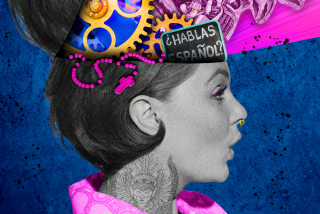Review: Valeria Luiselli’s ‘The Story of My Teeth’ is a collision of storytelling, lying and art
- Share via
“The Story of My Teeth” is a destabilizing read, a puzzle of a novel that at first seems explicable enough. Each successive chapter reveals new aspects and dimensions to the tale, giving the story new shapes and forms. When the book closes with a description that seems to fit all the parts in place, it’s satisfying yet appropriately mutable for a work that’s spent so much time playing with truth and fiction.
And it’s proof that Valeria Luiselli is one of the most exciting new writers working today.
It’s quite possible you haven’t heard of Luiselli; born in Mexico (and raised in the U.S., Costa Rica, South Korea and South Africa), she usually writes in Spanish, and her books are published in translation by the small, independent Coffee House Press. She is, however, breaking through: Her novel “Faces in the Crowd” won the L.A. Times’ Art Seidenbaum Prize for First Fiction in April, and she was named one of the National Book Foundation’s 5 Under 35 for 2014. Today Luiselli lives in New York, making her a greater presence to American readers.
SIGN UP for the free Essential Arts & Culture newsletter >>
That’s a good thing for readers who will thrill to her writing, who are fond of writers like Geoff Dyer and Ben Lerner, who hybridize the real and the imagined, who smile at a semiotics inscription and for those who like thinking about the intersection of storytelling and lying and art.
“The Story of My Teeth” begins with Gustavo Sánchez Sánchez, a.k.a. Highway, who lives on Disneylandia, a real street in Ecatepec, an industrial suburb of Mexico City. Highway sets out to straightforwardly tell the story of his teeth, which becomes the story of his life: A distant father, a disagreeable wife, eclectic collections, a career that turns from security guard to now-retired auctioneer.
Before his retirement, Highway took a philosophical approach to his craft. “I wasn’t just a lowly seller of objects but, first and foremost, a lover and collector of good stories, which is the only honest way of modifying the value of an object,” he explains at the start of the novel. Later, he tells stories about a set of contemporary art pieces from a nearby gallery, an auctioneer explaining to us why the work of Doug Aitken and Damián Ortega is so special. This is why museums have wall text: to create a narrative, and, as Highway says, the narrative creates value.
But there is a madness to his method. Highway believes the auctioneer’s highest art is to craft tales that shear away from the truth. He outlines his ideas as geometry — there are parabolic auctions, hyperbolic auctions, he explains. If at first these notions seem obscure, when he puts them into practice, it’s clear what he means.
He holds an auction to benefit the local church, an auction centered on his titular teeth. As he auctions them off — a pile of teeth removed from his own mouth — he invents fantastical provenances connecting them to his favorite writers. “I can assure you that this is one of Petrarch’s teeth,” he says, referencing the Italian Renaissance scholar. “One irrefutable proof is the fact that it is an exact reflection of his character…. Mr. Petrarch had a choleric nature, keen intelligence, and a weakness for sensual pleasures: he was hornier than a goat, and it’s easy to tell by just one look at the length of this incisor.”
The lie is enormous, but it is well told, and that really is the point. The wealthy residents of Ecatepec respond enthusiastically to his tales, bidding hundreds of dollars for them. Perhaps they are in on the joke, or the project, or perhaps they are dupes. It’s hard to say.
But there is one bidder who is not won over by Highway’s charms: the son he left behind when his marriage fell apart. We never really meet the son; now grown, he leaves the tooth auction with his father and then deposits him in a circumstance as mysterious and disorienting as a Sartre play.
There, in an empty room paneled with images of enormous clowns, Highway hears a voice. He’s given baffling challenges and harsh criticisms by the clowns, or a mysterious other — or maybe it’s himself, or someone he knows.
It’s here that our trust in Highway begins to slip. Giant malevolent clowns? Sure, the tooth auction seemed to be a kind of magical delusion, but how trustworthy can this narrator be? And in fact, another narrator appears, a young man who serves as an anchor to Highway’s flights of fancy.
Adding another frame to the book, Luiselli’s translator, Christina MacSweeney, has contributed a chapter that functions almost like a fact-checking timeline, listing dates of events in American and Mexican art, literature and politics, side by side. It’s an expansion of the book, Luiselli explains in her afterword, adding: “I revise and rewrite so thoroughly in English that I prefer to conceive of [my books] as versions rather than translations.”
Art fans may read of the scary clowns and think of the work of Ugo Rondinone; those who’ve been to Mexico City may have seen his video installation there. It showed at a gallery connected to the Jumex juice factory, in Ecatepec; not coincidentally, the book is dedicated to the factory staff. As photographs later in the book show, it turns out that the craziest parts of Highway’s story are anchored in reality.
At every turn, the book has this careful architecture, even if it feels like a strange, blind alley. Luiselli writes with a confidence that demonstrates she’s going somewhere.
::
The Story of My Teeth
Valeria Luiselli, translated by Christina MacSweeney
Coffee House Press: 184 pp., $16.95 paper
More to Read
Sign up for our Book Club newsletter
Get the latest news, events and more from the Los Angeles Times Book Club, and help us get L.A. reading and talking.
You may occasionally receive promotional content from the Los Angeles Times.







